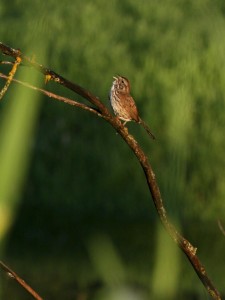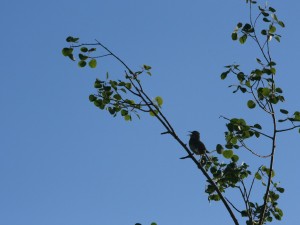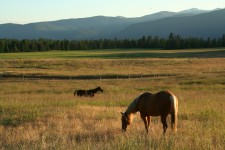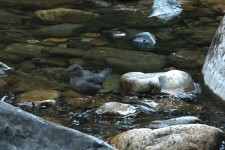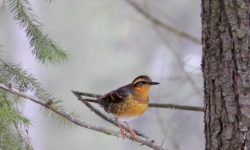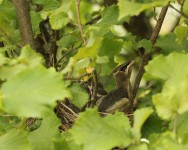The “cheer up, cheerily, cheerio, cheerily” of the American robin fills the air at the crack of dawn. A musical chorus ensues and tapers before sunrise.
Songs range from high to low pitched, long to short and simple to complex. Bird songs are unique to each species and generally only passerines (songbirds) sing.
Birds begin to sing songs in spring and continue into summer. The two main reasons birds sing are to defend territory and to attract mates. With those purposes fulfilled, a bird stops singing or reduces his singing greatly.
Males generally sing the songs, but females of a few species also sing, such as the red-winged blackbird.
Songs differ from calls. Both males and females call for alarm, to locate a mate, advertise food or to keep a flock together. A familiar call is that of the Canada goose during flight.
All vocalizations of birds originate in an organ unique to birds, the syrinx. The syrinx is similar to the larynx in mammals. Located at the first major branching of the windpipe (trachea), the syringeal muscles control membranes that restrict the air flowing through the tubes. When air is forced through the trachea, the thin membranes vibrate and produce sound.
Birds unable to use their syringeal muscles, such as turkey vultures, have limited vocalization. Birds with a complex musculature of the syrinx tend to produce a variety of bird songs. A brown thrasher can sing over 2,000 different songs.
Song complexity is not directly related to syrinx complexity as the Corvidae family demonstrates. Even though crows and jays have a complex syrinx, they are not great singers. However, they produce an impressive variety of sounds that are not considered musical.
With the location of the syrinx at the junction of the trachea, a bird can produce two sounds at once or breathe air in one side while the other produces sound. Each species produces a song that transmits the best in its environment.
Birds of wetlands tend to sing from elevated perches to minimize the interference of vegetation. In the forest, interference is everywhere and birds adjust their pitch accordingly.
Birds in the tree tops sing high-pitched songs because tree trunks don’t interfere with broadcasting. Birds residing in the understory sing low-pitched songs because a lower pitch travels through obstacles better.
With the background noise of streams and waterfalls, an American dipper sings a loud, ringing song so it can be heard.
Birds also know the best time to sing their song, which is typically morning. Before dawn the air tends to be still and there are fewer competing noises. A few birds sing during the day, at night or in the evening.
While each species has a signature song, there are individual variations. Often males are chosen by females because of their extensive song repertoire.
Others, such as the American robin, sing variations of the signature song. The song has all the same components but they are sung in a different order, enabling others to distinguish individuals when they sing a version of “cheer up, cheerily, cheerio, cheerily” at dawn and dusk.

